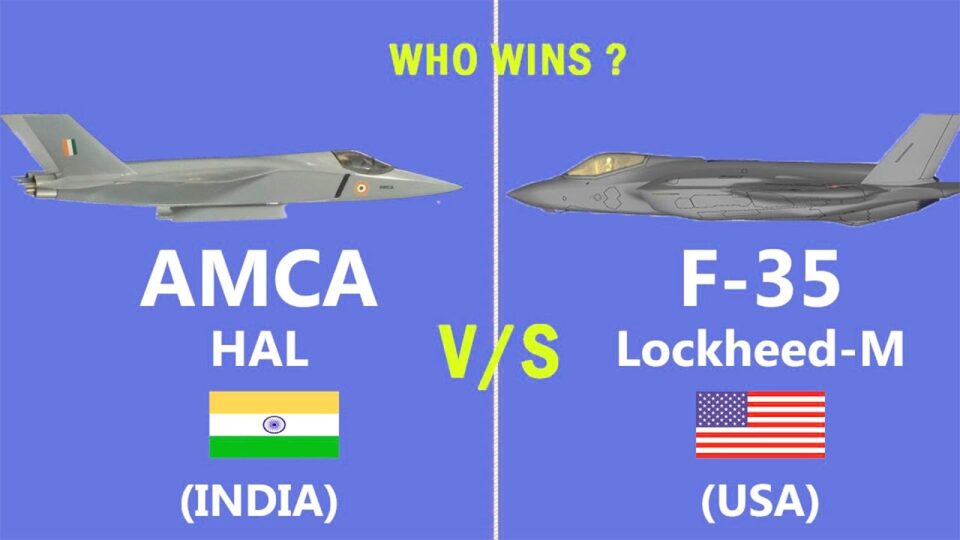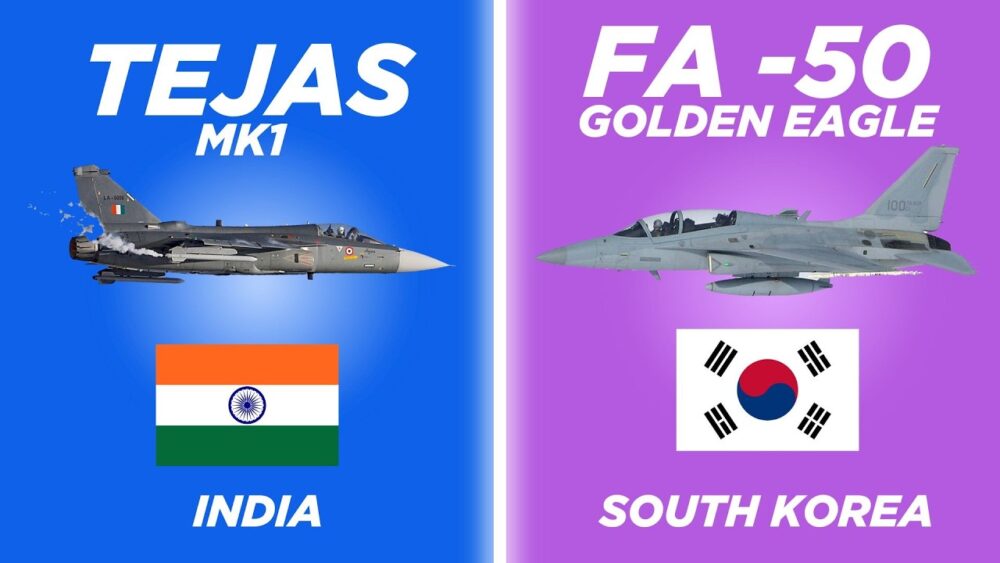Aircraft comparison
Comparison of India’s AMCA and American F 35

In the evolving realm of advanced military aviation, the Advanced Medium Combat Aircraft (AMCA) from India and the F-35 Lightning II from the United States stand as key symbols of their respective nations’ ambitions.
The AMCA, still in the development phase, embodies India’s strategic vision for a homegrown, cutting-edge fighter jet designed to meet future combat challenges. On the other hand, the F-35, an already operational marvel of American aerospace engineering, has set the standard for modern stealth and multi-role versatility.
Comparison of Russian Su30 and France built Rafale fighter jet
“In this comparison, we will delve into the two different fighters, the AMCA and the F-35, examining their technological innovations, strategic roles, and potential impacts on global air combat dynamics.”
The Advanced Medium Combat Aircraft (AMCA) is an advanced Indian fighter jet, featuring a single-seat, twin-engine design with all-weather capabilities and fifth-generation stealth technology. It is being developed for both the Indian Air Force and the Indian Navy, aiming to enhance India’s combat prowess with its multirole versatility.
In contrast, the Lockheed Martin F-35 Lightning II represents an American family of single-seat, single-engine stealth aircraft, known for its air superiority and strike mission capabilities. The F-35 also excels in electronic warfare and offers advanced intelligence, surveillance, and reconnaissance functions.
- The AMCA measures 17.6 meters (57 feet ) in length, while the F-35A is slightly shorter at 15.7 meters (51.4 feet).
Height:
- The AMCA stands at 4.5 meters (14 feet 9 inches) in height, whereas the F-35A is marginally taller at 4.4 meters (14.4 feet).
Wing Area:
- The AMCA’s wing area is 55 square meters (590 square feet), whereas the F-35A has a significantly larger wing area of 43 square meters (460 square feet).
Empty Weight:
- The AMCA has an estimated empty weight of 12,000 kilograms (26,455 pounds), while the F-35A’s empty weight is 13,290 kilograms (29,300 pounds).
Maximum Takeoff Weight:
- The AMCA’s estimated maximum takeoff weight is 25,000 kilograms (55,116 pounds), compared to the F-35A’s maximum takeoff weight of 29,900 kilograms (65,918 pounds).
Fuel Capacity:
- The AMCA has a fuel capacity of 6,500 kilograms (14,300 pounds), while the F-35A carries 8,278 kilograms (18,250 pounds) of internal fuel.
Maximum Speed:
- The AMCA can achieve a maximum speed of Mach 2.15 (2,600 km/h or 1,600 mph), whereas the F-35A reaches a maximum speed of Mach 1.6 at high altitude and Mach 1.06 (700 knots or 806 mph) at sea level.
Range:
- The AMCA boasts a ferry range of 5,324 kilometers (3,308 miles) and a combat range of 1,620 kilometers (1,010 miles). In comparison, the F-35A has a range of 2,800 kilometers (1,700 miles) and a combat range of 1,410 kilometers (870 miles) in air-to-air configuration.
Service Ceiling:
The AMCA can reach a service ceiling of 20,000 meters (65,000 feet), while the F-35A operates up to 15,000 meters (50,000 feet).
In a bold step towards innovation, India’s Advanced Medium Combat Aircraft (AMCA) program is set to revolutionize its production process with 3D printing technology. By integrating 3D printing, HAL anticipates substantial benefits ranging from cost reduction and faster turnaround times to optimized material usage. The adoption of 3D printing not only promises to streamline production but also offers opportunities to mitigate material waste, a critical challenge in aerospace manufacturing.
The F-35 A design is robust; in contrast to its 8,000-hour design life, its service life has been evaluated to reach 24,000 hours. The F-35A has an extremely low radar cross-section, at 3.8mm, which reduces its radar profile. Multiple software and processor updates have been made to the F-35A. Progress includes improved weapon capability and electronic warfare systems. The current version, known as Block 3F baseline, is moving towards Block 4, with software and weapon improvements planned twice yearly in 2024.
The AMCA is currently being developed and will have sophisticated avionics, including an electronic pilot function. A fighter platform typically needs two pilots. One is a pilot who flies, while the other is a mission pilot (who directs the flying pilot). Only one cockpit and an electronic pilot will be present on this jet. As a way to improve situational awareness and collaborate with the advanced electronic warfare (EW) suite onboard the AMCA, distributed passive sensors with AI-assisted multi-sensor data fusion are anticipated.
The F-35 Lightning II features a single-seat cockpit with advanced automation and AI, enabling the pilot to handle both flying and mission-critical tasks. Its Distributed Aperture System (DAS) offers a 360-degree view, enhancing situational awareness. Supported by an advanced electronic warfare suite, the F-35’s AI-driven sensor fusion integrates data from various sensors, providing a complete battlefield picture. This technology reduces the pilot’s workload and significantly boosts the aircraft’s combat effectiveness.
since HAL realised the primary goals and advancements needed for AMCA for future aviation projects when constructing aircraft. In collaboration with international suppliers and via innovative research for newer weapons, the Defense is advancing its weaponry. The Brahmos air-to-ground missile, ASTRA, RUDRAM, Laser guided, and precision munition pods will all be made available by the AMCA. Radar and infrared search and tracking features are some additional elements that aid aircraft detection.
The F-35 features two internal weapon bays and four weapon stations. There are air-to-air missiles at the two inboard weapon stations. Among the air-to-surface weapons for the outboard station are the Joint Direct Attack Munition, the Paveway line of bombs, the Joint Standoff Weapon, and cluster munitions. The AIM-9X or AIM-132 ASRAAMs can be mounted on either of the wingtip pylons, which are canted outward to lower the radar cross-section.

Aircraft comparison
Comparison of the Indian built Tejas MK1A vs South korean FA 50

Today, we’ll explore two remarkable light combat aircraft: the Tejas MK1A and the FA-50 Golden Eagle. Both fighters are designed for versatility, making them ideal for various missions, from air-to-air combat to ground support.
The Tejas MK1A, developed by Hindustan Aeronautics Limited (HAL) in India, and the FA-50, a product of Korea Aerospace Industries (KAI), are both advanced aircraft equipped with modern technology and features.
10 Fascinating Facts About India’s AMCA Fighter Jet
In this Article, we will compare these two fighters in terms of their specifications, performance, capabilities, and roles in modern air forces. Let’s dive in and see how they stack up against each other!
Tejas is the second supersonic combat aircraft developed by Hindustan Aeronautics Limited (HAL), following the HF-24 Marut. It took its first flight in 2001 and was inducted into service with the Indian Air Force (IAF) in 2015. Currently, Tejas holds the distinction of being the smallest and lightest aircraft in its class of supersonic combat jets.
On the other hand, the FA-50 is South Korea’s first indigenous supersonic aircraft and is one of the few supersonic trainers in the world. Development of the T-50 began in the late 1990s, with its maiden flight taking place in 2002.
Russia Seeks Talks with India, Offers Tu-160 Bombers at Unbeatable Prices
The FA-50 boasts a higher production rate compared to the Tejas. Over the past 15 years, Korea Aerospace Industries (KAI) has produced nearly 200 variants of the FA-50, while Tejas has seen a lower production output.
In terms of international sales, the FA-50 is actively in service with multiple countries, including Indonesia, Iraq, the Philippines, Thailand, and Poland. Notably, Malaysia opted for the FA-50 over the Tejas, citing the FA-50’s strong service record as a key factor in their decision.
Here’s a SPECIFICATION of the Tejas and FA-50
Length: The Tejas measures 13.2 m (43 ft 4 in), making it slightly longer than the FA-50, which is 13.14 m (43 ft 1 in).
Max Takeoff Weight: The Tejas has a maximum takeoff weight of 13,500 kg (29,762 lb), compared to the FA-50’s lighter weight of 10,722 kg (23,638 lb).
Fuel Capacity: The Tejas has an internal fuel capacity of 3,060 liters (810 US gallons), while the FA-50 has a slightly lower internal fuel capacity of 2,655 liters (701 US gallons).
Powerplant: Both aircraft are powered by General Electric F404 turbofan engines, but the Tejas utilizes the F404-GE-IN20 variant with 48.9 kN (11,000 lbf) thrust dry and 85 kN (19,000 lbf) with afterburner. The FA-50 features the F404-GE-102 variant, producing 53.07 kN (11,930 lbf) thrust dry and 78.7 kN (17,700 lbf) with afterburner.
Maximum Speed: The Tejas has a maximum speed of 2,220 km/h (Mach 1.8), which is significantly faster than the FA-50’s maximum speed of 1,837.5 km/h (Mach 1.5).
Combat Range: The Tejas has a combat range of 739 km (459 mi), whereas the FA-50 has a much longer range of 1,851 km (1,150 mi).
Hardpoints: The Tejas features 9 hardpoints with a total capacity of 5,300 kg, while the FA-50 has 7 hardpoints capable of carrying up to 5,400 kg of payload.
Cost: The Tejas is priced at approximately $40 million per unit, whereas the FA-50 ranges between $30 million to $40 million per unit, making the FA-50 potentially more cost-effective depending on the variant chosen.
Weapons
When it comes to weaponry, the Tejas MK1A offers a wider range of options compared to the FA-50 Golden Eagle. The Tejas MK1A is equipped with beyond-visual-range (BVR) missiles, allowing it to engage targets at greater distances, enhancing its combat effectiveness in air superiority missions. Additionally, it can carry precision-guided munitions for accurate strikes against ground targets, as well as standoff weapons, which can be launched from a distance to minimize exposure to enemy defenses. This diverse armament enables the Tejas to perform a variety of roles, from air-to-air combat to ground support.
In contrast, the FA-50 also features a respectable armament capability but has a more limited selection. It can carry air-to-air missiles like the AIM-9 Sidewinder and AIM-120 AMRAAM, as well as precision-guided bombs. However, its focus leans more toward close air support and light strike missions rather than the extensive versatility that the Tejas offers.
Naval Variant
The Tejas Mk1A has a naval variant designed for carrier operations, which is still in development. This version includes upgrades like a nose droop for better visibility during landings and takeoffs, a strengthened undercarriage, and an arrestor hook for safe landings on aircraft carriers.
In contrast, the FA-50 does not have a naval variant. While it’s versatile for different missions, it’s not designed for carrier operations, limiting its flexibility compared to the naval Tejas, which can operate from both land and carriers.
-

 Aviation2 months ago
Aviation2 months agoMicrosoft Flight Simulator Raises $3 Million to Bring Back the An-225 Mriya
-

 Airlines2 months ago
Airlines2 months agoQantas Engineers Stage Walkout Over Cost of Living Concerns
-

 Airlines2 months ago
Airlines2 months agoQatar Citizens Can Travel to the United States Without a Visa
-

 Aviation2 months ago
Aviation2 months agoQatar Airways bans these new Electronic Devices on plane
-

 Airlines2 months ago
Airlines2 months agoJapan Airlines Rolls Out Free Domestic Flights to International Passengers
-

 Defence2 months ago
Defence2 months agoWhich Country Has the Largest Fleet of Fighter Aircraft?
-

 Airport2 months ago
Airport2 months agoWestern Sydney Airport Welcomes Its First Plane After 6 Years of construction
-

 Aviation2 months ago
Aviation2 months agoDid you know ? Once Boeing 747 carried 1088 passenger in 1991








